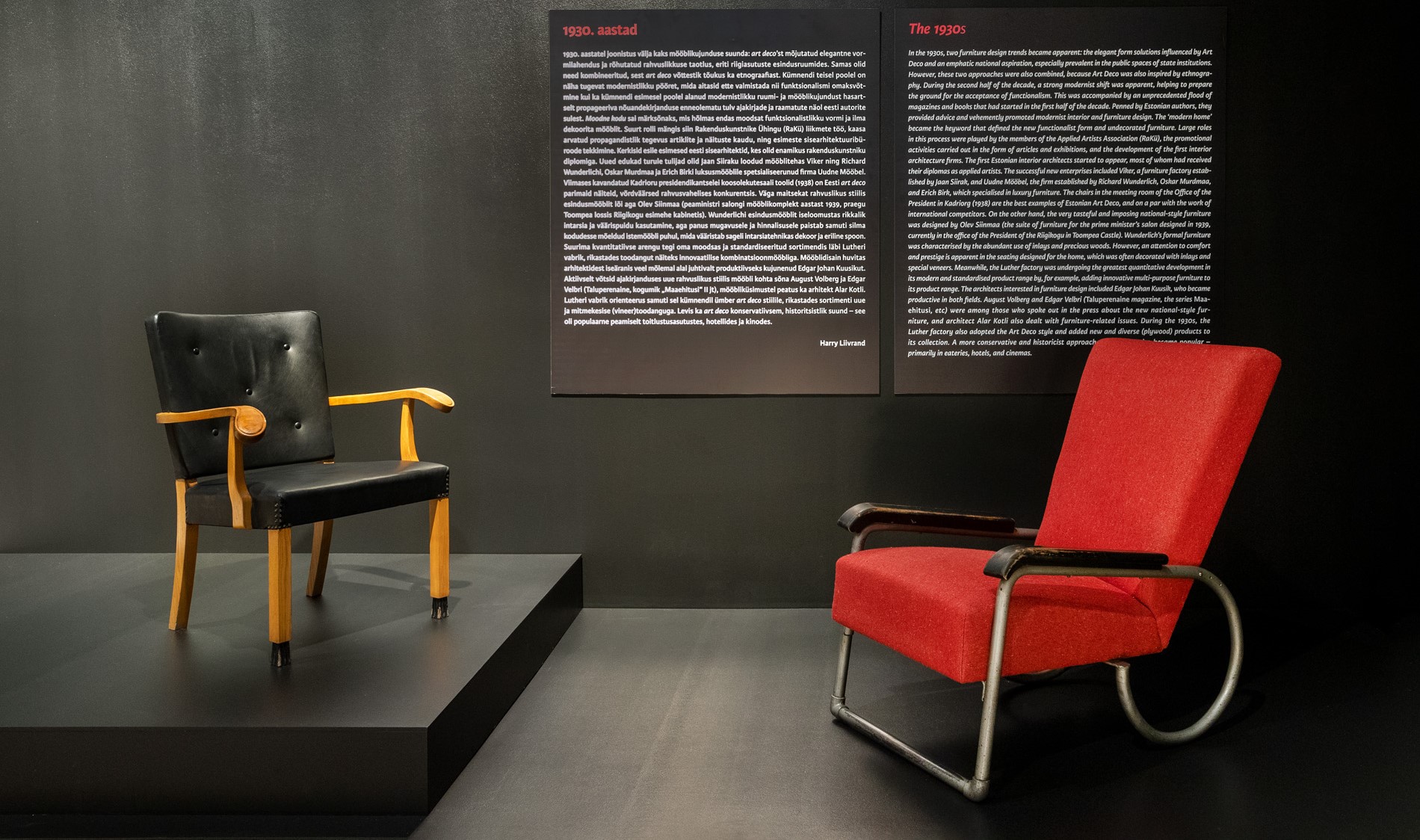
Photo: Anu Ansu ja Berta Vosman (ERM)
Last chance to see the exhibition ‘Story of the Estonian Chair’
Monday, 28. jan 2019
In the gallery (B-entrance)
The exhibition, titled ‘The Story of the Estonian Chair’, on 100 years of Estonian chair design will be open until June 30. The exhibition, which was created in cooperation with the Estonian Association of Interior Architects, is curated by art researcher Harry Liivrand, designer Lilian Sokolova and interior architect Katrin Tammsaar.
The exhibition examines the history of Estonian furniture chronologically and via style history from the beginning of the 1920s until the second decade of the 21st century. The ENM will be exhibiting iconic chairs that can be found in public spaces and in many homes, as well as chairs once popular but lesser known to people today.
“These are chairs that have made history in domestic furniture design – as both unique items and industrial products,” said Harry Liivrand, one of the exhibition’s curators. “We chose chairs without which we simply couldn’t imagine our design history, and chairs whose uniqueness is a symbol of time, since limited possibilities determined the number of chairs produced.”
The exhibition will showcase chairs from famous interiors, such as the chamber of the parliament of Estonia (1920s), a society house in Tallinn (Tallinna Seltskondlik Maja, 1920s), the administrative building of Kadriorg Palace (1930s), the Pegasus café in Tallinn (1960s), the assembly hall of the University of Tartu (1960s), Tallinn Town Hall (1970s), the Eeslitall restaurant in Tallinn (1980s) and the Estonian embassy in Beijing (2010s).
However, the exhibition will also include products made by large furniture manufacturers, such as plywood chairs from the Luther factory in Tallinn, furniture designed by Jaan Siirak for the Viker factory, products from the Standard integrated furniture factory in Tallinn, as well as items by Tarmeko and Mang. Creations by village carpenters will also be displayed, as they also form part of the history of the Estonian chair.
The exhibition mostly showcases chairs from private collections, but also from the collections of the Estonian National Museum, the Museum of Estonian Architecture and the Estonian Museum of Applied Art and Design. The attractive layout of the exhibition sees the chairs reunited with the rooms for which they were created.
The Estonian Association of Interior Architects organised an open competition for the exhibition, with the ‘Story of the Estonian Chair’ project announced as the winner in January 2018.
The producer of the exhibition is Reet Mark (ENM) and the graphic design is by Eva Unt and Margus Tammik (Unt/Tammik). The exhibition is supported by the Cultural Endowment of Estonia, Akzo Nobel Baltics and Fagerhult.
The following supporting members of the Estonian Association of Interior Architects have also contributed to the exhibition: Bauhof Group, Decoland, E-Lux Kodutehnika, Elke Mööbel, Floorin, Geberit, Hektor Light, Jung, Lincona Konsult, Mass, Moodne Valgustus, Plaadipunkt, Plaat Detail, Puustelli, RM Stuudio, Tarkett, Villeroy&Boch Gustavsberg AB Estonian branch, Vivarec, Wermstock, InterStudio, Glamox HE, I.D. Kangas, and Björn Espresso Bar.
The exhibition examines the history of Estonian furniture chronologically and via style history from the beginning of the 1920s until the second decade of the 21st century. The ENM will be exhibiting iconic chairs that can be found in public spaces and in many homes, as well as chairs once popular but lesser known to people today.
“These are chairs that have made history in domestic furniture design – as both unique items and industrial products,” said Harry Liivrand, one of the exhibition’s curators. “We chose chairs without which we simply couldn’t imagine our design history, and chairs whose uniqueness is a symbol of time, since limited possibilities determined the number of chairs produced.”
The exhibition will showcase chairs from famous interiors, such as the chamber of the parliament of Estonia (1920s), a society house in Tallinn (Tallinna Seltskondlik Maja, 1920s), the administrative building of Kadriorg Palace (1930s), the Pegasus café in Tallinn (1960s), the assembly hall of the University of Tartu (1960s), Tallinn Town Hall (1970s), the Eeslitall restaurant in Tallinn (1980s) and the Estonian embassy in Beijing (2010s).
However, the exhibition will also include products made by large furniture manufacturers, such as plywood chairs from the Luther factory in Tallinn, furniture designed by Jaan Siirak for the Viker factory, products from the Standard integrated furniture factory in Tallinn, as well as items by Tarmeko and Mang. Creations by village carpenters will also be displayed, as they also form part of the history of the Estonian chair.
The exhibition mostly showcases chairs from private collections, but also from the collections of the Estonian National Museum, the Museum of Estonian Architecture and the Estonian Museum of Applied Art and Design. The attractive layout of the exhibition sees the chairs reunited with the rooms for which they were created.
The Estonian Association of Interior Architects organised an open competition for the exhibition, with the ‘Story of the Estonian Chair’ project announced as the winner in January 2018.
The producer of the exhibition is Reet Mark (ENM) and the graphic design is by Eva Unt and Margus Tammik (Unt/Tammik). The exhibition is supported by the Cultural Endowment of Estonia, Akzo Nobel Baltics and Fagerhult.
The following supporting members of the Estonian Association of Interior Architects have also contributed to the exhibition: Bauhof Group, Decoland, E-Lux Kodutehnika, Elke Mööbel, Floorin, Geberit, Hektor Light, Jung, Lincona Konsult, Mass, Moodne Valgustus, Plaadipunkt, Plaat Detail, Puustelli, RM Stuudio, Tarkett, Villeroy&Boch Gustavsberg AB Estonian branch, Vivarec, Wermstock, InterStudio, Glamox HE, I.D. Kangas, and Björn Espresso Bar.


